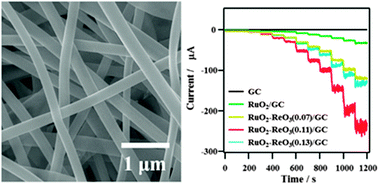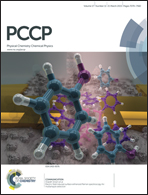RuO2–ReO3 composite nanofibers for efficient electrocatalytic responses†
Abstract
We present a facile synthetic route to ruthenium dioxide (RuO2)–rhenium oxide (ReO3) electrospun composite nanofibers and their electrocatalytic responses for capacitance and H2O2 sensing. The contents of rhenium oxide of electrospun ruthenium dioxide (RuO2) were carefully controlled by an electrospinning process with the preparation of the precursor solutions followed by the thermal annealing process in air. The electrochemical applications of RuO2–ReO3 electrospun composite nanofibers were then investigated by modifying these materials on the surface of glassy carbon (GC) electrodes, RuO2–ReO3(n)/GC (n = 0.0, 0.07, 0.11, and 0.13), where n denotes the relative atomic ratio of Re to the sum of Ru and Re. Specific capacitance and H2O2 reduction sensitivity were remarkably enhanced depending on the amount of ReO3 increased. Among the four compositions of RuO2–ReO3(n), RuO2–ReO3(0.11)/GC showed the highest performances, i.e., a 20.9-fold higher specific capacitance (205 F g−1 at a potential scan rate (v) of 10 mV s−1; a capacity loss of 19% from v = 10 to 2000 mV s−1) and a 7.6-fold higher H2O2 reduction sensitivity (668 μA mM−1 cm−2, normalized by GC disk area), respectively, compared to only RuO2/GC.


 Please wait while we load your content...
Please wait while we load your content...